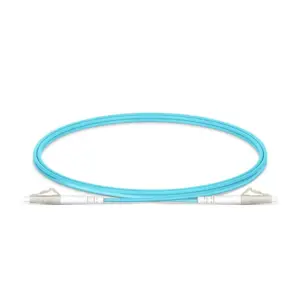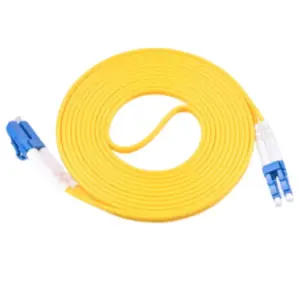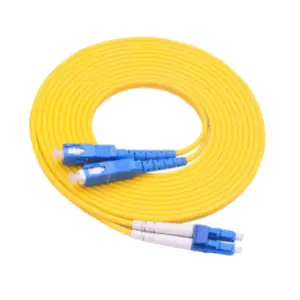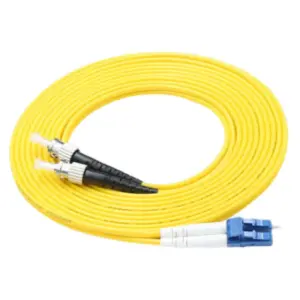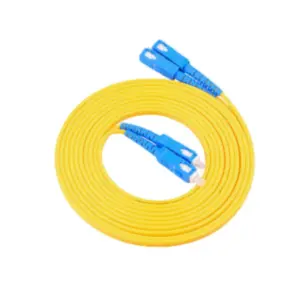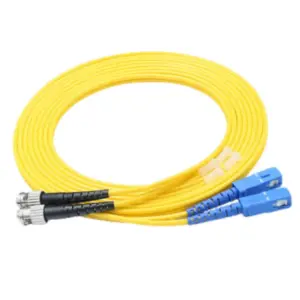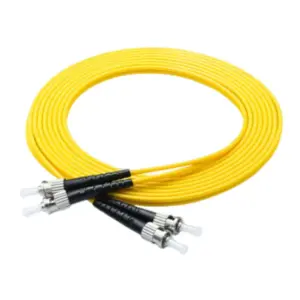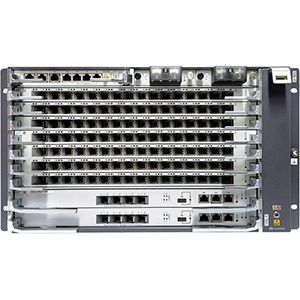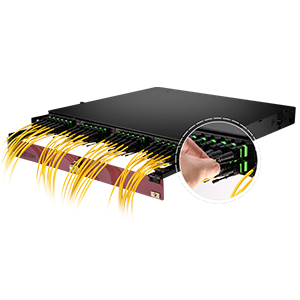Welcome to read this article. I will introduce you to the basic concepts, working principles and applications of single-mode fiber (Single Mode Fiber) in various fields. Single-mode fiber is a commonly used fiber type that is characterized by supporting only a single transmission mode.
In this article, we’ll explore the definition and fundamentals of single-mode fiber to help you understand how it works and how it differs from multimode fiber. The principle of optical signal transmission in single-mode fiber will reveal to you why the single-mode fiber core only supports a single transmission mode.
Different types of single-mode fiber have different core sizes and refractive indexes, and we will discuss their effects on optical signal transmission. In addition, we will compare the differences in bandwidth and attenuation characteristics between single-mode fiber and multi-mode fiber to give you a more comprehensive understanding of the characteristics of single-mode fiber.
Finally, we will look at the future development trends of single-mode fiber. High-speed optical communication and optical fiber sensing technology innovation will become a key development direction in the field of single-mode optical fiber. We look forward to exploring the frontiers of single-mode optical fiber technology with you and providing you with innovative communications and sensing solutions.
Introduction to single-mode optical fiber
Definition and rationale:
Single Mode Fiber is an optical fiber transmission medium that only supports the propagation of optical signals in a single transmission mode. Single-mode fiber has a smaller core diameter, typically 9 microns, and a cladding diameter of approximately 125 microns. It uses the principle of total reflection of light to transmit optical signals along the central axis of the optical fiber to achieve high-speed, long-distance data transmission.
Single mode transmission:
The principle of supporting only a single transmission mode in single-mode fiber is based on the propagation characteristics of light and the structure of the fiber. The following is an explanation of single-mode transmission:
-
Propagation characteristics of light: Light is an electromagnetic wave with different propagation modes, such as main mode, high-order mode, etc. Each transmission mode corresponds to a beam shape propagating in the fiber.
-
Structure of optical fiber: The core diameter of single-mode optical fiber is very small, usually on the order of several light wavelengths (about 9 microns). In contrast, multimode fiber has a larger core diameter, usually on the order of dozens of light wavelengths (around 50 or 62.5 microns).
-
Principle of total reflection: When light travels from one medium to another medium with a lower refractive index, refraction occurs. The propagation of light in an optical fiber depends on the refractive index distribution of the optical fiber. The core diameter of single-mode fiber is very small, so that the light beam can only propagate in the main mode, while the higher-order modes will suffer greater refraction and energy loss, making it impossible to maintain effective transmission.
Single-mode fiber only supports a single transmission mode due to the structure of the fiber and the propagation characteristics of light. This enables single-mode optical fiber to achieve longer transmission distances and higher transmission rates, and is widely used in long-distance communications and high-speed optical communication systems.
Types and characteristics of single-mode optical fiber
Core size and refractive index:
The effects of core size and refractive index of single-mode fiber on optical signal transmission are interrelated. Below is a discussion of its impact:
-
Core size: The core size of single-mode fiber is usually small, generally 9 microns. The smaller core size enables the beam to propagate in a single transmission mode, reducing inter-mode dispersion and distortion, enabling longer range transmission and higher bandwidth capabilities.
-
Refractive index: The refractive index of single-mode fiber is a key parameter for light propagation in the fiber. The refractive index determines the propagation speed and transmission performance of light beams in optical fibers. By adjusting the refractive index of the optical fiber, the transmission characteristics of the single-mode optical fiber can be optimized and the attenuation and distortion of the optical signal can be reduced.
Bandwidth and Attenuation:
Single-mode fiber has the following characteristics, involving bandwidth and attenuation considerations:
-
Bandwidth: The bandwidth of single-mode fiber refers to the frequency range that the fiber can transmit. Since single-mode fiber only supports a single transmission mode, its bandwidth is higher than that of multi-mode fiber. The bandwidth of single-mode optical fiber is usually on the order of several THz (terahertz), which is suitable for transmitting high-speed data and broadband signals.
-
Attenuation: Attenuation is the energy loss of optical signals during transmission in optical fibers. Single-mode fiber generally has low attenuation, typically in the range of 0.2 to 0.5 dB per kilometer. In comparison, multimode fiber has higher attenuation. Low attenuation enables single-mode fiber to achieve longer transmission distances and higher signal quality.
Comparison with multimode fiber optic cable:
Compared with multimode fiber optic cables, single-mode fiber optic cables have the following advantages:
-
Bandwidth: Single-mode fiber has a larger bandwidth and can support higher data transmission rates and a wider frequency range.
-
Transmission distance: Due to low attenuation, single-mode optical fiber is suitable for long-distance transmission and can cover distances of tens to hundreds of kilometers.
-
Dispersion: Single-mode fiber has less dispersion, which can reduce signal distortion and delay.
-
Compatibility: Since single-mode optical fiber supports a single transmission mode, it has good compatibility with many optical fiber equipment and optical fiber communication systems.
To sum up, single-mode optical fiber has the characteristics of large bandwidth, low attenuation and suitable for long-distance transmission, making it an ideal choice for high-speed and long-distance optical communication systems.
Application fields of single-mode optical fiber
Long distance communication:
Single-mode optical fiber is widely used in long-distance communications, including telecommunications and Internet backbone networks. The following are the applications of single-mode optical fiber in long-distance communications:
-
Telecommunications network: Single-mode optical fiber is a key technology for building telecommunications networks worldwide. It is used to carry various communication services such as telephone, Internet, data communication and video transmission. The low attenuation and high bandwidth capabilities of single-mode fiber allow signals to be transmitted over long distances without loss of quality or speed.
-
Internet backbone network: Single-mode optical fiber connects network nodes and data centers around the world in the Internet backbone network. It provides high-speed and stable data transmission, meeting the needs of large-scale data transmission and cloud computing.
Fiber optic sensing technology:
Single-mode optical fiber has a wide range of applications in the field of optical fiber sensing technology, including optical fiber temperature and pressure sensors. The following are the applications of single-mode optical fiber in optical fiber sensing technology:
-
Fiber optic temperature sensor: By utilizing the fiber Bragg grating (FBG) structure of single-mode fiber, the fiber can be converted into a high-precision temperature sensor. When the optical fiber is subjected to temperature changes, its reflection spectrum changes, thereby achieving temperature measurement. Fiber optic temperature sensors have a wide range of applications in industrial, medical and environmental monitoring fields.
-
Fiber optic pressure sensor: Fiber optic pressure sensor uses the fiber Bragg grating or bending effect of single-mode fiber to measure pressure changes. By monitoring light intensity, light frequency or phase changes in optical fibers, highly sensitive and precise pressure measurements can be achieved. Fiber optic pressure sensors are widely used in industrial control, aerospace and medical fields.
In addition to the above application areas, single-mode optical fiber also plays an important role in lasers, sensor networks, fiber amplifiers and fiber laser radar. Its high performance and reliability make it the basis of modern communication and sensing technology.
Fiber optic splices and connections for single-mode fiber
LC and SC connectors:
LC (Lucent Connector) and SC (Subscriber Connector) are common single-mode fiber optic connector types. They have the following characteristics and uses:
-
LC connector: The LC connector is a small connector with a relatively small size and is suitable for high-density fiber optic connections. It uses a 1.25mm ceramic or plastic socket with low insertion loss and return loss. LC connectors are commonly used in applications such as data centers, local area networks, and fiber-to-the-home (FTTH), and are particularly suitable for scenarios that require high-density connections.
-
SC connector: SC connector is a commonly used square connector that uses a 2.5mm ceramic or metal socket. It has good mechanical stability and precise alignment capabilities, making it suitable for a variety of single-mode fiber applications. SC connectors are commonly used in enterprise networks, telecommunications equipment, and fiber optic sensing.
Correct methods and precautions for fiber optic connection:
When making single-mode fiber connections, here are some correct methods and precautions:
-
Cleaning and inspection: Before connecting, make sure the fiber end is clean and smooth. Use appropriate cleaning tools and solvents to remove dirt and grease from the fiber ends. Use a microscope or fiber inspector to inspect the fiber ends for damage or scratches.
-
Align and insert: Gently align the connector with the fiber optic adapter or another connector and insert slowly along the axis. Ensure accurate alignment between the connector’s socket and adapter to avoid side stress and deflection.
-
Secure the connection: Once inserted, use the connector’s locking mechanism (such as a twist-lock latch) to hold it in place. Make sure the connectors are securely attached and cannot accidentally come loose or come off.
-
Avoid bends and tension: When laying out and installing fiber optic connections, avoid excessive bending or applying excessive tension. Excessive bending and tension can cause fiber damage and degrade signal quality.
-
Protect the connection: Use a protective sleeve or sheath to protect the connection part from external physical damage and environmental pollution.
-
Regular inspection and maintenance: Regularly check the status of the connection to ensure that the connector and fiber end face are clean, and replace damaged connectors if necessary.
Following correct fiber optic connection methods and precautions can ensure good connection quality and reliable signal transmission. Remaining careful and careful during the connection process, and using high-quality connectors and tools, can improve the performance and reliability of fiber optic connections.
Performance parameters and limitations of single-mode fiber
Signal attenuation:
In single-mode fiber, signal attenuation refers to the gradual weakening of optical signals during transmission. The main reasons for signal attenuation include the following aspects:
-
Absorption attenuation: The absorption of optical signals in optical fiber materials will cause energy loss. Different materials have different absorption characteristics for light of different wavelengths, so the degree of absorption attenuation also changes with the change of wavelength.
-
Scattering attenuation: The optical signal is scattered in the optical fiber, resulting in the diffusion and loss of signal energy. Scattering can be divided into various forms such as Rayleigh scattering and Bragg scattering, among which Rayleigh scattering is the most important scattering mechanism.
-
Bend attenuation: When the optical fiber is bent, the optical signal will be attenuated in the bend area. This attenuation is mainly due to mode field changes due to bending and energy loss due to scattering.
Signal attenuation limits the transmission distance and quality of single-mode fiber. Greater attenuation will cause the signal to decay faster during transmission, thereby reducing transmission distance and quality. In order to reduce signal attenuation, it is necessary to optimize the selection of optical fiber materials, the preparation process of optical fibers, and the quality of optical fiber connections.
Dispersion and nonlinear effects:
In addition to signal attenuation, there are also dispersion and nonlinear effects in single-mode optical fibers, which also have an impact on optical signal transmission.
-
Chromatic dispersion: Chromatic dispersion is the time expansion phenomenon caused by the different speeds of light at different wavelengths when optical signals propagate in optical fibers. The main dispersion mechanisms include dispersion caused by dispersion rate mismatch (dispersion dispersion and dispersion compression) and waveguide dispersion of optical fibers. Dispersion can cause signal distortion and pulse broadening, limiting the transmission distance and rate of high-speed, broadband signals.
-
Nonlinear effects: At high optical powers, nonlinear effects in optical fibers become significant. Among them, the most important nonlinear effects are self-phase modulation (SPM), fiber Kerr effect (FKE), four-wave mixing (FWM), etc. These effects can cause frequency conversion, phase distortion and power fluctuations of optical signals, adversely affecting the transmission quality and stability of the signal.
The effects of dispersion and nonlinear effects can be suppressed and compensated through technical means such as fiber design and signal modulation. For example, dispersion compensating fiber (DCF) is used to offset dispersion effects, or nonlinear effects are reduced by optimizing the material and structure of the fiber.
The future development of single-mode optical fiber
High-speed optical communication:
Single-mode optical fiber will continue to play an important role in the field of high-speed optical communications, and will present the following trends and application prospects with the development of technology:
-
High-rate transmission: With the rise of applications such as cloud computing, big data, and high-definition video, the demand for high-rate optical communications continues to increase. Future development will move towards higher data transmission rates, such as 400Gbps, 800Gbps or even higher rate optical communication systems.
-
High-density connections: As data centers and communication networks continue to expand, there is a growing need for high-density fiber optic connections. Future single-mode fiber optic connectors and fiber optic connection technologies will facilitate high-density layout to enable the interconnection of more fiber optic channels.
-
Long-distance transmission: Single-mode optical fiber has low attenuation and dispersion characteristics and is suitable for long-distance transmission. Future developments will further improve the transmission performance of single-mode optical fiber to support longer-distance optical communications, such as transcontinental optical cables and long-distance communications.
-
Photonic integration and on-chip optical communication: Photonic integration technology integrates different optical functions onto a single chip, enabling highly integrated and miniaturized optical communication systems. Future development will promote the integration of single-mode optical fiber and photonic integration technology to achieve higher performance and more compact on-chip optical communication solutions.
Fiber optic sensing technology innovation:
In addition to optical communications, single-mode optical fiber also shows broad application prospects in optical fiber sensing technology innovation, including the following emerging applications and development directions:
-
Optical fiber sensing network: Using the high sensitivity and long-distance transmission characteristics of single-mode optical fiber, a large-scale optical fiber sensing network can be constructed for monitoring and controlling the environment, structure, and safety. Optical fiber sensing networks have broad application prospects in smart cities, energy management, industrial automation and other fields.
-
Biomedical Sensing: The tiny size and biocompatibility of single-mode optical fiber give it potential in the field of biomedical sensing. Single-mode fiber optic sensors can be used in applications such as biological parameter monitoring, drug delivery, and tissue imaging in vivo, providing new tools and methods for medical diagnosis and treatment.
-
Optical fiber chemical sensing: Single-mode optical fiber combined with specific functional materials can realize optical fiber chemical sensors for detecting and analyzing chemical substances. This kind of sensor can be used in environmental monitoring, food safety, water quality testing and other fields to provide fast, sensitive and real-time chemical analysis methods.
-
Structural health monitoring: By embedding single-mode optical fiber sensors in the structure, real-time monitoring of the structural health status can be achieved. This application can be used for safety assessment and fault diagnosis of buildings, bridges, aircraft and other structures, providing a new means for the maintenance and upkeep of engineering structures.
In the future, with the continuous advancement of technology and the growing demand for applications, single-mode optical fiber will continue to usher in more developments and innovations in high-speed optical communication and optical fiber sensing technology innovation. This will promote progress in the fields of optical communications and sensing, bringing more applications and opportunities to information transmission, environmental monitoring, medical diagnosis and other fields.
Summarize:
By reading this article, you have a deeper understanding of the definition, working principle and application areas of single-mode fiber. Single-mode optical fiber plays an important role in fields such as long-distance communications and fiber-optic sensing technology. Understanding the proper fiber splices and connection methods, as well as the performance parameters and limitations of single-mode fiber, will help you take full advantage of its benefits in practical applications.
In the future, innovations in high-speed optical communications and optical fiber sensing technologies will promote single-mode optical Development in fiber field. We look forward to exploring the new frontiers of single-mode optical fiber technology with you and providing you with reliable communications and sensing solutions.
-
Customized single mode duplex fiber optic patch cords
-
LC-LC single mode duplex fiber optic patch cord
-
LC-SC single mode duplex fiber optic patch cord
-
LC-ST single mode duplex fiber optic patch cord
-
SC-SC single mode duplex fiber optic patch cord
-
SC-ST single mode duplex fiber optic patch cord
-
ST-ST single mode duplex fiber optic patch cord


